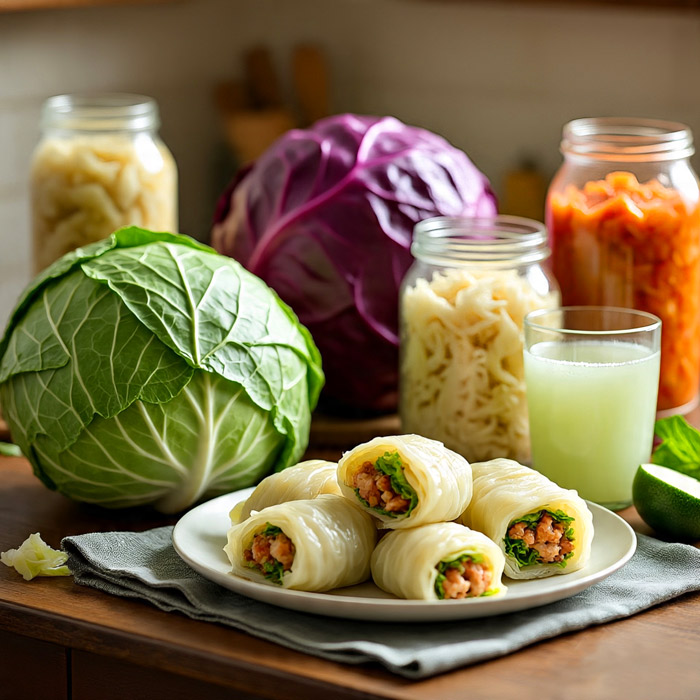
Please call us to find out about our services.
 856-691-2497
| Fax 856-692-9007
856-691-2497
| Fax 856-692-9007

Fresh cabbage is best because it holds the most nutrients, flavor, and crunch. As it ages, it loses vitamin C, wilts, and may develop a strong smell or bitter taste. Older cabbage can also become rubbery or soggy when cooked. For texture and nutrition, fresher is better.
Cabbage is nutritious, offering numerous vitamins and minerals that help maintain good health. It contains vitamin C, an antioxidant that supports immune health and skin vitality. Vitamin K, another important nutrient in cabbage, helps maintain healthy bones and assists in blood clotting. It's also a good source of fiber, promoting healthy digestion and regular bowel movements. Additionally, cabbage provides small amounts of calcium, potassium, magnesium, and iron, minerals necessary for balanced body function.
The antioxidants in cabbage, such as beta-carotene and polyphenols, fight inflammation and reduce oxidative stress. This potentially helps protect the body against various illnesses. Regular consumption of cabbage can aid in maintaining healthy cholesterol levels, beneficial to heart health.
Cabbage is popular in weight loss programs for several reasons. It's low in calories, with just about 25 calories per 100 grams, yet very filling due to high fiber content. This helps individuals maintain fullness without consuming many calories. The fiber in cabbage also slows digestion, keeping hunger at bay for longer periods.
Diet plans frequently include cabbage because it's easy to prepare and incorporate into various dishes. Its adaptability makes it convenient for individuals seeking manageable meal planning. Cabbage soup diets, although short-term, highlight cabbage's potential in low-calorie eating plans. However, incorporating cabbage regularly into balanced meals is healthier and more sustainable for long-term weight management.
Cabbage comes in several different types, each offering unique tastes, textures, and uses:
Green cabbage is the most common type. It has tightly packed, smooth leaves with a mild, sweet flavor suitable for salads, slaws, and cooking.
Red cabbage offers vibrant color and slightly tougher leaves. It holds up well in cooking and pickling and adds appealing color to salads.
Savoy cabbage features crinkled, tender leaves, more delicate in texture compared to green cabbage. It's excellent for stir-fries and steamed dishes.
Napa cabbage, or Chinese cabbage, has oblong leaves and a mild flavor. It's common in Asian cuisines, especially stir-fries, kimchi, and soups.
Bok choy, another variety of Chinese cabbage, features crunchy stems and tender leaves, ideal for quick cooking methods like stir-frying and steaming.
Proper cabbage storage maintains freshness and nutritional value. Whole heads of cabbage store best in the refrigerator's crisper drawer. Keeping cabbage in plastic wrap or airtight plastic bags helps maintain moisture, preventing it from drying out or wilting quickly. A fresh, whole cabbage head can last up to two weeks if properly stored.
Cut cabbage requires slightly different handling. Once sliced, place it in an airtight container or sealed plastic bag to retain freshness and prevent discoloration. Cut cabbage typically remains fresh for five to seven days.
Avoid washing cabbage before storage, as moisture can lead to faster spoilage. Wash it thoroughly under cool running water just before use to remove any dirt or pesticides.
Cabbage is incredibly versatile, making it suitable for countless dishes across many cuisines. Here are several popular ways to include cabbage in various types of foods:
In salads and slaws, cabbage provides crunch and freshness. Its sturdy texture remains crisp, even when dressed ahead of time.
Cabbage soups and stews offer comforting, nutritious meals. Adding cabbage toward the end of cooking retains its texture and nutrients.
Fermented foods, like sauerkraut and kimchi, highlight cabbage's potential as a probiotic-rich ingredient, supporting digestive health.
In stir-fries and sautéed dishes, cabbage cooks quickly, offering a nutritious component without compromising taste or texture.
Pickling cabbage is another common culinary practice, resulting in dishes with longer shelf lives and unique flavors. Pickled cabbage often accompanies sandwiches or serves as a tangy side dish.
Stuffed cabbage rolls, common in Eastern European cuisines, combine cabbage leaves with hearty fillings, showcasing cabbage's adaptability.
Try this aromatic, savory Cabbage with Green Beans & Carrots Recipe.
Cabbage offers substantial nutritional benefits and dietary flexibility, encouraging healthier eating practices without sacrificing flavor or satisfaction. Understanding the different varieties, proper storage methods, and the diverse dishes it complements makes it easier to integrate cabbage into everyday diets. Its affordability and adaptability further add to its appeal as a consistently valuable dietary ingredient.